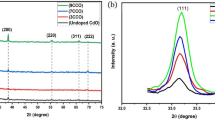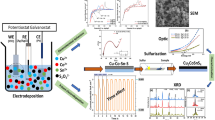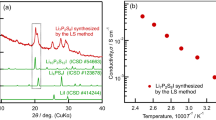Abstract
Potentiometric CO2 gas sensors with Li conducting glasses/glass ceramics of the system Li2O-Al2O3-SiO2 (different nominal composition) as solid electrolytes have been investigated. Li2CO3 was used as CO2 and O2 sensitive auxiliary electrode. During the sensor test measurements, the CO2 partial pressure was varied between 1×10−3 and 1×10−1 bar at a constant O2 partial pressure of 2.1×10−1 bar whereas N2 was used as carrier gas. Comparative measurements were accomplished with sensors comprising Na and K ion conducting glasses.
A metastable reference electrode was formed at the contact zone between the Au metal electrode and the former Li glasses of definite nominal composition by crystallization processes taking place, which lead to stable, reproducible CO2 dependent EMF signals for more than 90d. The thermodynamically expected EMF difference and the observed EMF difference agree quite well between 500 and 600 °C.
At 600 °C, the drift of sensors with glasses as solid electrolytes and direct Au glass/glass ceramics contact as reference electrode amounts typically 0.32 mV/d (p(CO2)=1×10−3 bar, p(O2)=2.1×10−1 bar at the measuring electrode), if a metastable multiphase equilibrium is formed. At identical partial pressures of CO2 and O2, the signal reproducibility of these sensors with different solid electrolyte glasses of the same nominal composition lies within 30 mV at 600 °C.
Similar content being viewed by others

6. References
M. Gauthier and A. Chamberland, J. Electrochem. Soc.124, 19 (1977).
W.F. Chu, H. Erdmann, V. Leonhardt, M. Ilgenstein, German Patent DE 40 22 136 A1.
O. Schäf, G. Schäfer, J. Arndt, Proceedings Sensor 1993, 6. Int. Fachmesse mit Kongreß für Sensorik und Systemtechnik, Nürnberg 11–14.10.1993, Vol. 6, 89–96.
BMFT-project “Fundamentals of Chemical Sensors with Solid Ionic Conductors”, Förderkennzeichen [13 AS 140 A1].
H. Schettler, Ph.D. Thesis, University of Stuttgart 1994.
T. Maruyama, S. Sasaki and Y. Saito, Solid State Ionics23, 107 (1987).
T. Maruyama, X.-Y. Ye and Y. Saito, Solid State Ionics24, 281 (1987).
O. Schäf, Ph.D. Thesis, Free University of Berlin 1995.
H. Rickert, Electrochemistry of Solids, Springer-Verlag Berlin 1982.
G. Hötzel, Ph.D. Thesis, University of Stuttgart 1986.
I. Barin, Thermochemical Properties of Inorganic Substances, VCH Weinheim 1989.
Author information
Authors and Affiliations
Rights and permissions
About this article
Cite this article
Schäf, O. Reference electrode formation in potentiometric CO2 sensors with alkali ion conducting alumosilicate glasses as solid electrolytes. Ionics 2, 274–281 (1996). https://doi.org/10.1007/BF02376034
Received:
Issue Date:
DOI: https://doi.org/10.1007/BF02376034



